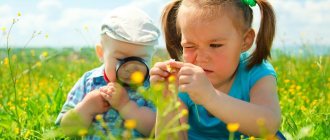Goals and objectives of environmental education
Technological progress and the rapidly developing chemical industry lead to the fact that the ozone layer is constantly thinning, drinking water supplies are decreasing, and the “lungs of the planet” - forests and groves - are disappearing.
And all this is the result of the irrational and merciless use of natural resources, which do not have time to recover. Articles on the topic
- How to raise your son to be a real man: the main truths 08/24/2021
- How to raise a successful child: 10 effective tips 07/12/2021
- Parenting techniques: how to change a child’s views and behavior 05.26.2021
- Functions of education in the formation of personality 05.26.2021
To prevent further destruction of nature, environmental education of preschoolers, schoolchildren, students and even adults who have not previously been instilled with the basics of environmental culture is necessary.
It is important to teach a child to respect nature and appreciate it as early as possible, while explaining why this is necessary. Most of this work is carried out by workers in preschool institutions, where children spend most of their time. An important fact is the involvement of parents, grandparents, brothers and sisters in this process. This way, a large number of people of different ages will be involved in the problem of environmental conservation.
The main goal of environmental education is to form in preschoolers and schoolchildren a humane attitude towards nature and its resources, to create a personality that is able to understand and realize the fact why it is important to love and protect nature in all its diversity. Perceive yourself as a part of the surrounding world, capable of creating material and spiritual values based on natural resources.
The child must understand that he can actively interact with nature in such a way as to create new benefits without destroying the beauty of the world around him.
Over many years, sufficient theoretical and practical material has been accumulated on the environmental education of preschool and school-age children.
For this purpose the following tasks are set:
- fostering a caring attitude towards the world;
- formation of environmental consciousness;
- developing interest in nature;
- directing children's active efforts to preserve natural resources.
To solve these problems, they use ecological moments, nature excursions, various experiments, educational games, living corners, and winter gardens.
Current problems of environmental education
Currently, the environmental education system faces a number of problems.
The problem of changing the value system and correcting the worldview . This problem is due to the fact that quite often teachers of educational organizations are faced with the fact that the child has a distorted idea of the importance of the environment in the life of every person. In this case, it is necessary to rebuild the child’s consciousness for the subsequent effective formation of an ecological culture.
The problem of establishing the limits of permissibility of transforming nature in the interests of society. The teacher must help each child develop a definition of the acceptable measure of transformation of the surrounding nature, formulate standards of behavior, the observance of which will contribute to the further existence of humanity on the planet.
The problem of realizing the inevitability of punishment when committing environmental offenses. This problem is that not all children fully understand the importance of a reasonable relationship between society and nature. In the minds of most children, environmental offenses are not something serious and punishable. It is necessary to introduce environmental laws that permeate all economic activities of mankind and form the basis of resource-saving technologies. It is necessary to convey to children that only compliance with environmental legislation is the key to the further prosperity of the planet.
The problem of the relevance of the provided environmental knowledge and the real needs of modern society in the knowledge and personal qualities of children . This problem is that in the process of environmental education, the teacher must not only convey to children certain knowledge about nature, the environment, ecology, etc., but also develop in them certain environmental competencies and qualities. The effectiveness of environmental education is determined by the child’s presence of such qualities and competence as the ability to think critically, find alternative solutions to problems, take responsibility for one’s own actions, adapt to real conditions, etc. In addition, it is assumed that each child should develop the desire and ability to independently find the necessary information and apply it for its intended purpose.
Note 2
Thus, environmental education is associated with many problems in developing in children the necessary environmental knowledge, skills, abilities and practical experience in various life situations.
Features of the process for different age groups
Environmental education of schoolchildren and preschoolers is an integral part of education. At each stage, teachers use various forms of presenting material and forms of teaching that correspond to the psycho-emotional and physical development of the children.
Preschoolers
It is necessary to start environmental education from preschool age, when a small person:
- forms the basis of environmental thinking;
- accumulates his knowledge about various forms of life;
- he lays the initial elements of ecoculture.
During this period of life, children are very sensitive and receptive, their physical and mental development proceeds at a rapid pace, and basic moral qualities and character traits are formed. At the age of 3-7 years, significant changes occur in the sphere of cognition of a small person. Imaginative thinking predominates and the child establishes relationships with the world around him through direct impressions.
Preschool children have unstable attention. They quickly lose interest in one subject and switch to another, getting tired. Therefore, the “spiral” principle is used to study the natural world. Each topic is studied in small portions. Then, year after year, they return to it, deepening and expanding knowledge, using more complex techniques.
Play and love for nature
The main way of learning in preschool age is play.
Therefore, environmental education in kindergartens is carried out using games with natural elements (pebbles, shells, leaves), board games with cards (for example, putting together a picture of nature from several cards). Active games are also necessary. The game “Edible and Inedible” develops imagination well and systematizes knowledge about nature.
Theoretical knowledge is necessarily supported by practice (communication with nature, visiting a winter garden, working on a personal plot). All this contributes to the long-term preservation of children’s interest and attention to studying the world around them.
An important detail in children’s environmental education is the teacher’s response to questions that interest them. Children are inquisitive; in addition to kindergarten, they learn a lot of new things about nature from their parents, from the Internet and TV. Naturally, they have questions. And the teacher must not only convey knowledge, but also develop the logical and creative thinking of children.
The following classes are used for this:
- in the winter garden;
- living corner;
- in nature in the form of a trip, a fairy tale, a quiz.
This way, children not only consolidate the material they have covered, but also learn something new for themselves.
MAGAZINE Preschooler.RF
Modern issues of environmental education of preschool childrenThe article was prepared by the teacher of the preschool group of the MB OU S (K) NSh-DS No. 2, Neryungri RS (Yakutia), Natalya Petrovna Baidina
Human interaction with nature is an extremely pressing problem of our time. Probably everyone remembers the words of the famous writer A. de S. Exupery “... we all come from childhood .
If you look at today's children, you can see that some children do not understand that everything that surrounds us is living nature, our Earth, our home, and we must learn to love and take care of it all. And from children's environmental permissiveness (pluck a flower, destroy a butterfly) to adult (turn rivers, cut down a cedar forest) is just one step. And to prevent this step from being taken, it is necessary to form the foundations of environmental education already at preschool age.
The ideas about nature, as it really is, acquired in childhood, arouse deep interest in children, expand their knowledge, contribute to the formation of character, make them kinder and more tolerant.
And the biographies of many famous people convince us of this: natural scientists K.A. Timiryazeva, I.V. Michurina; famous poets, writers, artists, composers - A. Pushkin, V. Bianki, M. Prishvin, G. Skrebitsky, P. Tchaikovsky and many others. It is very good when children are read poems, fairy tales, stories about nature - preschoolers try to understand, comprehend what they read, ask questions, base their answers on the basis of their still small life experience. And if kids love direct communication with nature, then older preschoolers can already talk about more global problems that relate to interaction with the surrounding nature.
As you know, the 21st century is predicted to be information-ecological. This fact confirms the priority of environmental education and education of preschoolers and students.
However, according to UNESCO Director General F. Mayor, this problem can be solved, but only “through global education” , i.e. placing environmental issues at the center of all educational programs, starting in preschool.
But posing the question in this way is not accidental - environmental education has not achieved high results. As for preschool education, the search for effective strategies and technologies is still underway, and a wide variety of approaches are being considered.
Some experts believe that it is necessary to introduce thematic classes, since environmental education is not identical to biological education. Others advocate for the effective “greening” of the entire educational process. And it should be noted that the second approach is receiving increasing support today.
As noted by modern ecologists S.D. Deryabo and V.A. Yasvin, today it is vitally important to green all spheres of public life, and first of all, the person himself must be greened in all aspects of his activities - in everyday life, education, training. Two models of entering a new reality are considered - through the development of personality based on an “active offensive-affirming” attitude towards the world around us (S. A. Rubinstein) and on the ability to create for the benefit of humanity (A. N. Leontyev).
When setting environmental goals, issues of mental, aesthetic, moral, ethical, and physical education are resolved.
Mental development occurs in the process of children’s knowledge of inanimate nature, plants, animals and protozoa; accessible to the sensory perception of children; connection between objects and natural phenomena.
It is necessary to show children nature as it really is, influencing the senses. It is also necessary to cultivate children's interest in observed phenomena. It is necessary to show what and how to observe in animals and plants, pay attention to appearance - movements, habits, thus forming not only knowledge about nature, but also children’s attitude towards it.
Research in recent years shows that the development of cognitive activity in preschool children increases due to their acquisition of the ability to find significant features in plants and animals, to establish connections between the structure of individual organisms and the living conditions of plants and animals.
In the moral development of a child, a special place is given to the development of a careful, caring attitude towards all living things.
An aesthetic attitude is expressed in the development of the ability to see the beauty and variety of colors of nature. It can be noted that preschoolers’ lack of knowledge that correctly reflects reality often leads to the formation of various prejudices and superstitions. Misconceptions often cause hostile attitudes towards animals and children’s destruction of “ugly” insects and reptiles. This harms not only nature, but also the child’s fragile psyche and hardens him. That is why it is important for children to receive correct information about the world around us from a very early age.
But environmental education is somewhat broader in content. It is based on awareness of human activities for the environment.
Environmental education is possible under the following conditions: the formation of elementary ecological ideas about nature (about animals and plants as living beings; about the unity of the organism and the environment; about the essence of interaction between man and nature); understanding the importance of environmental protection; nurturing a humane and active attitude towards nature, expressed in a careful and caring attitude towards living beings; in awareness of the fulfillment of certain norms of behavior.
Children learn these rules well in didactic, environmental games, remember how to behave and what to do so as not to harm nature.
And of course, not only the children’s educational institution educates and educates in the environmental sphere, but also parents, first of all, instill norms of behavior in their children - both in the theater and in the forest. So, in conclusion, we can say that how a little man will grow up depends on the thoughts and actions that his “put” into his soul and heart. And whether he will be empathetic, sensitive and attentive towards nature also depends on what he was taught in childhood.
Bibliography
- Marinicheva O.V., Elkina N.V. We teach children to observe and tell. A popular guide for parents and teachers. - Yaroslavl: Academy of Development, 1997. - 224 p., ill.
- Goroshchenko V.P. Nature and people., M.: Education, 2006.
- Dmitriev Yu.D. We have one land., M.: Children's literature, 2007.
- Nikolaeva S.N. Education of ecological culture in preschool childhood., M.: Prosveshchenie, 2009.
| Next > |
The importance of environmental education of the population
In the modern world, environmental education and environmental education play an extremely important role. Today our reality is radically different from what people saw around them several centuries ago. The environmental crisis is what humanity is facing in our time.
That is why environmental education today is extremely relevant and important. Environmental education was created to ensure that the population develops correct environmental consciousness. Environmental education is interdisciplinary in nature, that is, it is implemented within the framework of various sciences.
Environmental education helps people realize that they are the ones responsible for everything that happens on our planet, that it is we who can help preserve the wealth of our nature.




